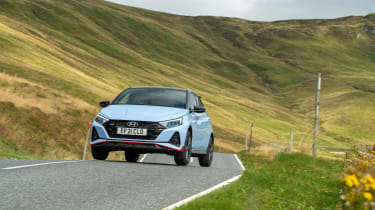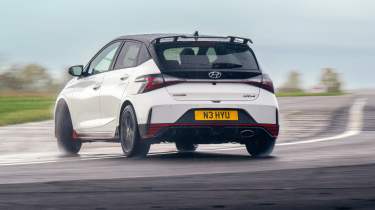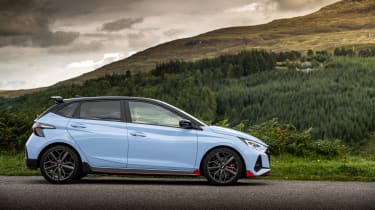Hyundai i20 N (2021 - 2024) review – a cracking supermini hot hatch
An inspiring hot hatch from Hyundai N. Agile, and with a limited slip differential that offers superb mid-corner traction, it's a formidable Fiesta ST rival
The story of Hyundai’s N brand is one created by a golden age of automotive globalisation. Take one ambitious, cash-rich mainstream manufacturer that’s slowly built a global empire of increasing market share, employ the legacy industry’s brightest minds and leave them too it with a budget to match. It might have seemed to come out of nowhere, but the N brand’s success certainly wasn’t by accident. So after hitting the ground running with the brilliant i30 N, Hyundai gave us a different portion size of the same meal in its i20 N.
Before its discontinuation in 2024, this supermini-sized hot hatchback sat in a field of only a few. Once a hotbed of some of the most engaging cars on sale, iconic names such as Peugeot, Renault, Citroën and Ford have vacated the segment, leaving only Volkswagen and arguably Toyota (as its GR Yaris rivals in terms of size, but not price or performance) at this entry point of the hot hatchback market.
> Hyundai i30 N and i20 N axed
In issue 318's 18-car hot hatch mega test, the i20 N achieved a very respectable fifth place overall, and this wasn't purely down to its low price. But we’ll point out that you could buy an i20 N for six grand less than the disappointing Mini JCW, or only a grand more than the 208 GT. The i20N shows it’s possible to produce a fantastic hot hatch that isn’t on the wrong side of £30k. So why aren’t more companies doing it?
And glory be, these things are good. Along with the bigger i30N and the Civic Type-R, but more so even than the GR Yaris and AMG A45 we sent ahead of it into the top four, the little Hyundai feels right from your very first moments interacting with it.
The cabin is clearly built down to a price but it’s easy on the eye, and scratchy out-of-reach plastics don’t matter when all the touch-points are spot on. Steering wheel: round, chunky but not BMW-thick, clear buttons for the driving modes and rev-matching function. Gearknob: spherical, as it should be, and attached to a slick mechanism. Proper handbrake. Great seats. Clear, albeit TFT, dials.
The engine has the same crackling character and slightly nasal tone as the i30N’s, and the steering feels similar too, though its heft possibly feels less appropriate here than in the larger car – James remarks that while he concedes it’s a nit-pick, it makes the car feel heavier than it really is (which, as you’ll see from our figures, is the fourth-lightest here, and 220kg less than its larger sibling). You get used to it quickly though and there’s no faulting its accuracy or progression. Feedback could be better, but you actually don’t miss it that much.
On the road the i20N is pointy without being hyperactive, the passive suspension setup strikes a great balance between body control and bump absorption, and it’s compact enough to feel at home even on the narrowest, hedge-lined stretches. It just eats up whatever is in front of you, and allows you to make best use of its performance. Is it slower than the 300-horse stuff? Sure. Does it matter? Not really, since in the best tradition of small hatches, you can use what it’s got more often.
What’s strange is that it barely matters on the track either. While not immune from the juddering understeer suffered by most cars during our photography, the i20 is far happier to move around than it is on the road, with a balance so precisely throttle-adjustable that you can pick your angle of rotation almost to the degree. The brakes feel good too, and are more than up to shedding the N’s modest weight stop after stop.
Both James and John experience more rev hang and slightly more lethargic throttle response than they have with i20Ns in the past, so we’re putting that down to a quirk of this car alone, and fairly trivial in the greater scheme of things. Now the i20N is no longer around, it may be a long time before the next wave of electric equivalents are anything like as fun or affordable...
Hyundai i20 N: in detail
- Engine, gearbox and technical highlights > Features an effective and effervescent powertrain that’s a match for contemporary rivals, if not its historic ones
- Performance and 0-60mph time > Has all the performance you could reasonably expect at this price and size
- Ride and Handling > A top job from start to finish, it’s pointed, rambunctious and hilariously good fun
- MPG and running costs > A combined 40mpg-odd figure will be largely impossible to match unless you have a heart of stone
- Interior and tech > The basics are right and it comes with plenty of tech, but material quality isn’t a high point (or priority)
- Design > The exterior design is just as rambunctious as the driving experience. You can spec it subtly; why would you?
Prices and specs
Sadly, this is a class that’s seen a decline in numbers over recent years, as the increasing weight of cars in general and the move to purchasing more expensive, more powerful cars on finance has bitten hard into the smaller hot hatchback’s territory.
While the i20 N has now been axed entirely, it came in a single high-specification inclusive of all its high-spec chassis elements in its final iteration, with only an uprated BOSE sound system and the various colour options able to be specified on top.
The i20 N’s key rival was the Fiesta ST, but this too has now been discontinued. Volkswagen’s Polo GTI is available at £29,045, but despite the desirable moniker is rather flat and uninteresting to drive. Nor is it more comfortable, better built or more desirable than its rivals. Unlike the Ford and Hyundai, which feel lavished with care and attention in their development, the VW feels like a distinct afterthought. If it wasn’t, VW has bigger issues to deal with.
Toyota’s GR Yaris is a similar size to comparable superminis, but is a more serious machine both in terms of performance and price. Entry-level models now come in at around £44,250, and don’t expect to go into a Toyota dealership and walk out with a new GR Yaris that week. Compounding the supply chain issues surrounding the whole industry, the GR Yaris itself is also limited by its hand-built nature in the off-site factory space that was once used to assemble the Lexus LFA.
Hyundai i20 N specs
| Engine | In-line 4-cyl, 1591cc, turbocharged |
| Power | 201bhp @ 5500rpm |
| Torque | 203lb ft @ 1750-4500rpm |
| Weight | 1190kg |
| Power-to-weight | 172bhp/ton |
| 0-62mph | 6.2sec |
| Top speed | 143mph |
| Basic price | £26,530 |




